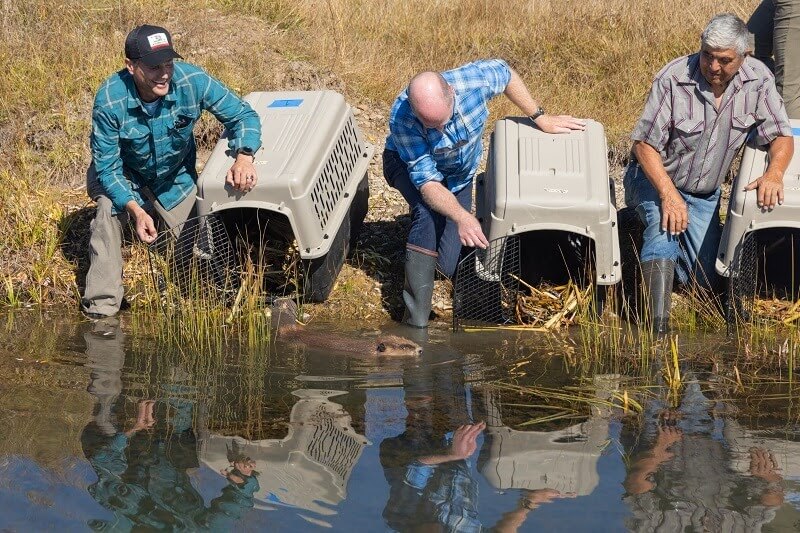Media Contacts:
Jordan Traverso, CDFW Communications, (916) 212-7352
Valerie Cook, CDFW Beaver Restoration Program, (916) 616-6366
Photo: CA Department of Fish and Wildlife
Beaver Reintroduction Conducted in Cooperation with Local Tribes
Media Note: A link to download photos and video of the beaver release is available at the bottom of the news release.
The California Department of Fish and Wildlife (CDFW) has launched the initial phase of its beaver translocation activities, recently conducting the first beaver conservation release in nearly 75 years. Working with the Maidu Summit Consortium, CDFW released a family of seven beavers into Plumas County, in a location that is known to the tribal community as Tásmam Koyóm.
The new family group of beavers join a single resident beaver in the valley with the ultimate objective of re-establishing a breeding population that will maintain the mountain meadow ecosystem, its processes and the habitat it provides for numerous other species.
Humans have so admired the skilled work of beavers they have spent millions of dollars trying to replicate the benefits they create. Thanks to Governor Gavin Newsom’s leadership and the State Legislature for supporting that leadership with funding in the state budget, beaver restoration is now part of a larger effort to help mitigate the impacts of wildfires, climate change and drought.
“Thanks to the leadership of our tribal partners and years of preparation, beavers are returning to their original homeland around the state,” said Governor Gavin Newsom. “California is restoring wildlife and critical habitat by working hand-in-hand with the tribes who have stewarded these lands.”
The historic release represents the first phase of CDFW’s North American beaver (Castor canadensis) restoration project, releasing beavers into the waters on the ancestral lands of the Mountain Maidu people. Soon to follow is a beaver reintroduction effort on the Tule River Reservation in the southern Sierra Nevada.
“Beavers help retain water on the landscape, which increases groundwater recharge, improves summer baseflows, extends seasonal flows and increases fuel moisture during wildfire season, effectively creating green belts that can serve as wildfire buffers or breaks and provide refugia for wildlife,” said CDFW Director Charlton H. Bonham, who joined the historic beaver release. “We look forward to duplicating these efforts on the Tule River Reservation in the southern Sierra Nevada mountains this spring.”
“This is the first time in decades our state agencies have reintroduced beaver into its original homelands with the leadership of our tribal partners at the Maidu Summit Consortium,” said California Natural Resource Agency Secretary Wade Crowfoot who also attended the beaver release. “Beaver relocation will help both to restore the environment and preserve traditional culture of our tribal partners who have stewarded these lands since time immemorial. I’m excited to watch how beaver will improve the health of landscapes in coming decades and support traditional lifeways for our diverse tribal communities.”
The translocation follows multiple years of site preparation that ensured adequate beaver habitat that provides protection from predators and can support beaver population establishment. These preliminary efforts were conducted through Maidu Summit Consortium’s collaboration with the U.S. Fish and Wildlife Service, Occidental Arts & Ecology Center’s WATER Institute, Lassen National Forest, Plumas Corporation, Swift Water Design, Symbiotic Restoration, Feather River Land Trust, The Sierra Fund, CalPBR Network and several others.
“Getting to this moment of our first reintroduction really is a product of so much leadership from so many people. We would not be here without the Tule River Tribe of California who have been out front advocating for these actions for years, tribes around the state like Karuk, and, of course, Maidu Summit Consortium leaders. The future looks much better because of these leaders,” Bonham said.
In alignment with CDFW’s new beaver depredation policy, the translocated beaver family was relocated from Sutter County, where their activity was damaging lands supporting several threatened or endangered species. To date, the entire family group, which consists of a breeding pair and their offspring, has survived. After exploring miles of habitat throughout the valley and locating the resident beaver’s territory, the family settled into the release area and has established shelter for the impending winter. The translocated beavers and receiving ecosystems will be monitored for multiple years following their release to assess the population, movement, habitat utilization, behavior and activity, potential conflicts, mortalities and the need for additional translocations, as well as the ecological changes that result from beaver engineering on the landscape.
More information about CDFW’s beaver management and restoration activities, or to obtain future updates about the translocated beavers, visit wildlife.ca.gov/Conservation/
###
Photos and video of the beaver release are available for download at the following CDFW FTP site: Beaver Translocation


